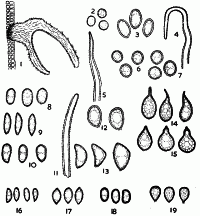|
 Calyptella hebe Calyptella hebe
SynonymsLachnella hebe
Cyphella hebe
BiostatusPresent in region - Indigenous. Endemic
Images (click to enlarge)
Caption: FIG. 9: Spores of Cyphella hebe. | 
Caption: FIG. 196. Lachnella hebe. Section through the pileus (a) and fusiform spores (b). |
Article: Cunningham, G.H. (1963). The Thelephoraceae of Australia and New Zealand. New Zealand Department of Scientific and Industrial Research, Bulletin 145: 359 p. Wellington:.
Description: Pilei annual, scattered, membranous-coriaceous, cupulate, 1-2.5 mm diameter, attached by
narrow bases; exterior bay, tan, or ferruginous, finely radiately striate, often splitting on
the posterior side, usually naked, rarely with a few scattered hairs; margin acute, slightly
inturned, entire or with one or two deep incisions; hymenial surface concave, even, pallid
cream. Context white, save for a few tinted hyphae near the periphery, to 80 µ thick, of
radiately arranged densely compacted parallel hyphae; generative hyphae 4-5 µ diameter,
walls to 2 µ thick, hyaline. Hymenial layer to 40 µ deep, a close palisade of basidia and
paraphyses. Basidia subclavate, 35-42 x 10-12 µ, bearing 4 spores, sterigmata arcuate,
slender, to 6 µ long. Paraphyses subclavate, 28-36 x 6-8 µ. Spores elliptic-fusiform, a few
suballantoid, ends bluntly acuminate, apiculate, 12-13 x 4-5 µ, walls smooth, hyaline, 0.2
µ thick.
Habitat: HABITAT: Scattered on bark of dead twigs.
Distribution: TYPE LOCALITY: Mt. Egmont, Taranaki, New Zealand.
DISTRIBUTION: New Zealand.
Notes: Lachnella hebe and L. totara resemble one another in shape and colour of the naked pilei.
They differ in several microfeatures, mainly in structure of the context and shape of the
spores. Exterior walls of occasional pilei appear as if delicately tomentose when examined
under a dissecting microscope, an appearance produced by brief ends of occasional
context hyphae which project slightly.
Article: Cunningham, G.H. (1948). New Zealand Polyporaceae. 3. The genus Polyporus. New Zealand Department of Scientific and Industrial Research, Plant Diseases Division, Bulletin 74: 39 p.
Description: Pilei annual, scattered, membranous, tough, cupulate, 1-2.5 mm. diameter, attached by a
narrow base; exterior bay-brown, tan, or ferruginous, concolorous, finely radiate-striate, often
splitting on the posterior side, not tomentose though sometimes with a few scattered hairs;
margin acute, slightly inturned, entire or with one or two deep incisions; hymenial surface
concave, even, pallid cream. Context white, save at the periphery, where a few hyphae are
tinted, to 80 µ thick, base to 350 µ, of radiately arranged densely packed sclerotioid hyphae;
generative hyphae to 5 µ diameter, wall to 2 µ thick, branched, septate, hyaline. Hymenial
layer to 40 µ deep, paraphyses subclavate. Basidia subclavate, 35-42 x 10-12 µ, 4-spored.
Spores elliptic-fusiform, a few suballantoid, bluntly acaminate at ends, 12-13 x 4-5 µ,
smooth, hyaline.
Habitat: HABITAT. Solitary on bark of dead twigs.
Distribution: DISTRIBUTION. New Zealand.
Notes: C. hebe and C. totara show a general resemblance to one another in shape and colour of the
naked pilei. In microfeatures they differ in context structure, and shape of the spores. C.
densa also possesses pilei with similar colour; but they are of different shape, much smaller,
often caespitose at the base, tomentose, and the spores are brown.
|